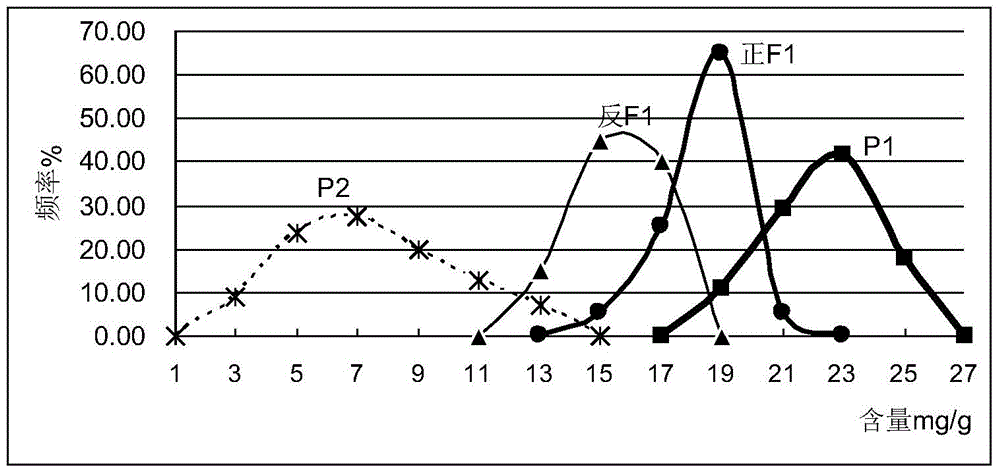Breeding method capable of reducing conversion rate of tobacco nicotine
A technology of nicotine conversion rate and conversion rate, applied in the directions of botanical equipment and methods, application, plant genetic improvement, etc., can solve the problems of increasing the difficulty of breeding, reducing the content of nicotine, and reducing the conversion rate of nicotine, etc. Achieve the effect of improving safety and comprehensive production performance, simple operation, and increasing costs.
- Summary
- Abstract
- Description
- Claims
- Application Information
AI Technical Summary
Problems solved by technology
Method used
Image
Examples
example 1
[0028] Example 1: Test of the influence of different hybridization methods on the conversion rate of nicotine.
[0029] 1. Test process and method:
[0030]1. In 2010, it was carried out in Enshi Tobacco Breeding Base. In order to avoid the influence of genetic differences in multiple traits among different varieties, the fertile lines of the same variety with different nicotine conversion rates (completely developed pistils and stamens, capable of self-fertilization) were selected as fertile lines (the pistil and stamens are fully developed and can be self-fertilized) after artificial multi-generation selection (the selection process is simple) Hybrid parent material. That is, Burley tobacco B37 strain with low nicotine conversion rate (referred to as P1) and B37 strain with high nicotine conversion rate (referred to as P2), 40 plants were planted in the field, and samples were taken at the stage of tobacco plant clusters to detect nicotine conversion rate, and P1 tobacco wa...
example 2
[0052] Example 2: Comparative test on the superiority of male sterile hybrid F1 nicotine conversion rate.
[0053] 1. Test process and method:
[0054] 1. Example (1) is the result of crossing with fertile lines. This example uses male sterility (MS) crossing to verify the conclusion that it can produce negative heterosis for nicotine conversion rate through crossing.
[0055] 2. In 2012, it was carried out in Enshi Tobacco Breeding Base. In order to exclude the influence of genetic differences of multiple traits in different varieties, different nicotine conversion rate types of the same variety were still selected as parents.
[0056] 3. The test materials include 2 male sterile lines of Burley tobacco with low nicotine conversion rate, MSTN90-20 and MSB37-4, 2 parts of Burley tobacco with high nicotine conversion rate TN90-9, B37-46, and 1 part Burley tobacco male sterile line MSTN86-22 with high nicotine conversion rate, 1 part of TN86-12 with low nicotine conversion rat...
example 3
[0076] Example 3, the comparison of the effects of reducing tobacco-specific nitrosamines (TSNA) in male sterile hybrid F1
[0077] 1. Test steps and methods
[0078] 1. Select the male sterility cross generation advantage utilization of tobacco as the breeding method.
[0079] 2. From 1998 to 2011, the multi-generation nicotine conversion rate selection and purification were carried out on the male sterile lines MSB21, MSTN86 and the corresponding maintainer lines B21, TN86, B37, and LAB21 respectively (purification process omitted). In 2012, after comparative identification, 6 copies The nicotine conversion rates of the varieties are all less than 5%, and the nicotine conversion rates and other characters of the sterile line and maintainer line are completely consistent except for fertility. "LC" (English abbreviation for low nicotine conversion) is added after the name of the purified variety to show the difference from the original variety.
[0080] 3. According to step ...
PUM
 Login to View More
Login to View More Abstract
Description
Claims
Application Information
 Login to View More
Login to View More - R&D
- Intellectual Property
- Life Sciences
- Materials
- Tech Scout
- Unparalleled Data Quality
- Higher Quality Content
- 60% Fewer Hallucinations
Browse by: Latest US Patents, China's latest patents, Technical Efficacy Thesaurus, Application Domain, Technology Topic, Popular Technical Reports.
© 2025 PatSnap. All rights reserved.Legal|Privacy policy|Modern Slavery Act Transparency Statement|Sitemap|About US| Contact US: help@patsnap.com



